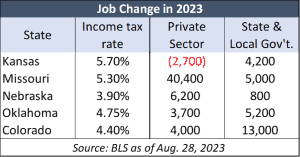Through the first seven months of 2023, seasonally adjusted numbers show Kansas has lost 2,700 private sector jobs, while adding about 5,000 government jobs.
According to numbers from the Bureau of Labor Statistics, in December of 2022, Kansas had about 1,191,600 private sector employees, and as of July, 2023, that number had dropped to around 1,188,900 employees, a drop of 2,700.
 However, the number of state and local government entities added 4,200 employees .
However, the number of state and local government entities added 4,200 employees .
Every neighboring state added government jobs, but Kansas is the only state that lost private-sector jobs,
Missouri added about 40,400 private sector jobs and 5,000 state and local jobs. Oklahoma added 3,700 private-sector jobs and 5,200 public-sector jobs. Nebraska saw private-sector job grow by 6,200 and only 800 state and local government jobs. Colorada also added more government jobs than the private-sector — 13,300 vs. 4,000.
While all four states saw an increase in public sector employees, only Kansas saw a job loss in the private sector.
Gannon Evans, policy manager and analyst for the Sandlian Center for Entrepreneurial Government — which like the Sentinel, is owned by the Kansas Policy Institute — said it comes down to tax policy. Some people move from state to state for tax reasons, but lower taxes also creates a more vibrant economy for job creation, which also prompts people to move.
“Aversion to long-term tax reform is exactly the same mindset that has mired Kansas behind other states in economic growth,” he said. “Right-sizing government and responsibly managing spending and taxation (is the fix).”
Only Iowa currently has a higher marginal tax rate on individual income, but it will drop to 3.9% when its tax relief law is fully implemented.



